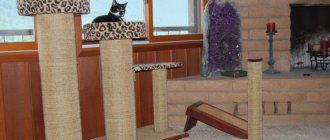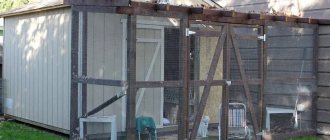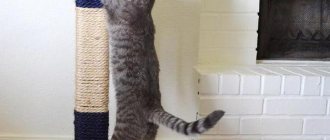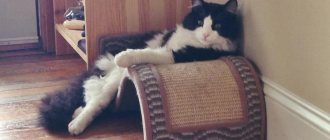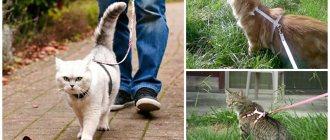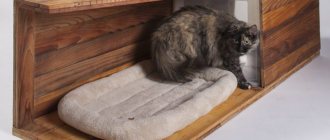Every owner knows that no matter how easy it is to care for a pet, the cat still requires attention and proper maintenance.
In a house where a cat lives, a scratching post is one of the main attributes. With the help of this accessory, the pet can sharpen its claws, and the cat owner will ensure the safety of the furniture and walls in the house.
The most popular homemade scratching posts (manufacturing instructions)
Any owner can make a scratching post for their pet themselves. First you need to choose the desired type of product and stock up on the appropriate materials.
Corrugated cardboard scratching post
This type is the most economical and environmentally friendly; its production does not require much time.
Materials needed: corrugated cardboard or cardboard boxes, thick paper, adhesive tape or PVA glue, knife.
One of the bloggers, Andrey Deveykin, made a scratching post in this form. Thanks to him for providing the photographs.
Manufacturing:
- lay out cardboard boxes, draw strips about 10-15 cm wide on them;
- cut out the resulting strips and start rolling them. The very first strip is the base of the structure. It needs to be rolled up as tightly as possible and secured with PVA or adhesive tape;
- gradually increase the volume by gluing strips and fixing them with tape or PVA;
- the last strip must be secured especially carefully so that it holds the entire structure and does not allow it to fall apart after the cat’s first attempt to sharpen its claws;
- The resulting scratching post must be placed on thick paper, circled around the edges and cut along the line. Glue the resulting paper figure to the bottom of the structure.
Corner scratching post
To make a corner model, you will need boards the width of a door frame. A thick fabric is attached over the boards or a thick rope made of natural materials is wound. When the product is ready, it is fastened on both sides of the outer corner.
Here is an example of step-by-step manufacturing of a corner scratching post:
- Take a board 200 mm wide and 1.2 meters long.
- Saw it in half.
- The result is two identical boards that need to be connected using dowels. It is better not to use self-tapping screws (since the cat, when sharpening its claws, may get into their cap). By the way, we must remember to process the cut edges so that our cat does not harm himself.
- Connect two pieces and make marks every 8 cm; there will be dowels in these places.
- We take dowels with a diameter of 6 mm and a length of 30 mm. Accordingly, in one of the workpieces you need to drill holes 15 mm deep (with a 6 mm drill) from the end in the marked places.
- You need to hammer the dowels into the resulting holes to equal lengths; you can use a square for this.
- In another workpiece, holes must be drilled from the front side.
- Next, fasten the workpieces using glue and wait until it dries.
- For upholstery, you can use carpet, first dividing it into two equal parts.
- You can secure the carpet using a stapler on the inside of the scratching post. The remaining part needs to be covered with glue and glued to the boards. And also attach the second end of the carpet using a stapler.
- You can attach the scratching post to the wall using the corners (bottom and top). You need to drill holes in the wall where the corners are attached, and then hang the scratching post using self-tapping screws.
- Afterwards, do not forget to check that the scratching post is holding well by hanging the cat on it).
Wall-mounted scratching post
The principle of its manufacture is the same as the corner version, but for the work one takes one wide board and attaches it to the wall so that the cat can easily reach it by standing up to its full height. It is important that the cat has free access to the scratching post. It is better not to place it in the bathroom or hallway. You need to determine where your pet spends the most time and place the device there.
Scratching post-post
For work you will need: a beam approximately 70 cm long and at least 5 cm wide, a round or square support made of wood about 4 cm thick.
Instructions for assembling the scratching post:
- On the support of the future claw handle, draw one line in the middle and a second line perpendicular to it, connecting them in the center. At the intersection point we will later attach the stand. We place the prepared beam in the middle of the support, then we outline its boundaries for further placement of self-tapping screws or self-tapping screws.
- We connect the support to the beam using glue and fasten them with self-tapping screws.
- We either leave the block in its original form or cover it with fabric, cutting out a piece with a width equal to the diameter of the stand, adding a couple of centimeters for the seams.
- We tightly wrap a thick rope over the fabric, tying it in a tight knot at the bottom of the block. By the way, the rope can be painted in several places, then the scratching post will look much more beautiful. The rope can be put on glue if it does not hold well.
Floor scratching post
This model is convenient because it does not take up much space in the apartment, it can be rearranged and taken with you on the road. The most simple version of a floor scratching post is an ordinary board covered with carpet. You can also wrap a thick twine around the base.
When making such a nail polisher, the main condition is the weight and stability of the device so that it does not drag on the floor when the cat decides to sharpen its claws.
By the way, here you can read an article about how to make a house for a cat with your own hands.
Wall models
This design is a flat object attached to the wall. It is made of boards and covered with jute or sisal cord. This cat accessory is suitable for those owners whose pets are persistently “interested” in wallpaper, damaging the walls in one or more favorite places.
The corner model also belongs to the category of wall-mounted scratching posts. It takes up less space due to the fact that two narrow planes are at an angle. The corner fixture can be placed both on the internal and external junction of the walls.
Wall products can be not only simple, but also complex structures with resting areas from which cats love to watch the household.
Such models have many advantages:
- compact, space saving;
- availability of installation anywhere;
- reliability of fastening;
- the ability to disguise damaged wallpaper;
- minimum costs when making a scratching post for a cat with your own hands.
The only drawback is that the structure is permanently attached to a specific place, which makes it difficult to carry. But this is not critical, since many pets are happy with a permanent place.
Why does a cat need a scratching post?
A cat, like any domestic animal, is by nature a wild creature endowed with natural instincts. Claws are an integral part of every member of the cat family.
With the help of claws, animals can not only climb trees, they need them to maintain balance when moving, during jumps and to secrete special odorous glands from their fingertips to mark their territory.
In addition, with the help of their claws, cats can fend for themselves in the event of an attack by another aggressive animal.
In the wild, cats took care of their claws to ensure their strength and maintain their shape by sharpening them on tree bark, stones, and dry grass.
A domestic cat does not need to hunt, but it is necessary to maintain the condition of its claws in any case, because if they are too long, it will interfere with the animal's walking and even cause him pain.
Without a scratching post, upholstery of upholstered furniture, carpets and wallpaper will be used, which is unlikely to bring joy to the owner. This is why it is so important to have a special device at home with which your cat can sharpen its claws.
What will be required for implementation?
Before you begin the process of making scratching posts for furry pets, you will need to resolve the issue of the premises that will serve as the production workshop. If you want to sell goods directly from the workshop, then you need to look for premises for production closer to the central part of the village or in the city center. In cases where you plan to sell products elsewhere or via the Internet, you can rent a workshop on the outskirts. Then you can save on rent.
Once the location issue has been resolved, you need to think about the equipment. To make scratching posts, you do not need to purchase expensive equipment. You need a standard set of tools: a jigsaw, a construction stapler, scissors.
The materials you need to buy are cotton wool, synthetic padding, polyurethane foam, carpeting or any thick textile for upholstery, plywood, cardboard for making the base. The cost of materials and tools will be approximately 20,000 rubles.
About the dangers of declawing
Teaching a cat to use a scratching post requires a lot of patience and time. Many owners who do not want to burden themselves with raising a pet may decide to take such a step as onychectomy, i.e. removal of the claw phalanx (operation “soft paws”). By the way, you can read a separate article about this operation on our portal.
It is in this operation that people see the solution to their problems with an unruly animal, forgetting about the irreparable harm that is caused to the cat. Without claws, a pet becomes disabled, cannot move normally, and will have to literally learn to walk again, shifting the center of gravity from the toes to the heel. This is equivalent to cutting off a person's toes.
This operation has a detrimental effect on the pet’s musculoskeletal system, problems with internal organs are possible, not to mention the fact that declawing will completely “unbalance” the cat, making it insecure and fearful. Once outside, such an animal is unlikely to last long.
Fortunately, many veterinary clinics are categorically against onychectomy and refuse this service to owners who apply.
An excellent replacement for “soft paws” is the use of anti-scratch pads. Read about which ones to choose and how to put them on your cat correctly on our website.
Financial calculations
Start-up capital
The main start-up costs for opening a scratching post shop include:
- paperwork – 3,000 rubles;
- rental of premises – 20,000 rubles;
- equipment, materials – 20,000 rubles;
- advertising – 30,000 rubles;
Total: 73,000 rubles.
Monthly expenses
Current expenses will include:
- rent – 20,000 rubles;
- purchase of materials – 8,000 rubles;
- employee salary – 15,000 rubles.
How much can you earn?
About 300 scratching posts will be produced and sold per month at an average cost of 500 rubles per unit; taking into account monthly costs, the net profit will be 77,000 rubles.
Payback period
It will be possible to recoup the investment in 1-2 months. But it is important to understand that it is unlikely that you will be able to sell all the goods produced in the first month. Some companies spend months accumulating clients. Success will largely depend on the manager's ability to find effective sales channels.
How to train a cat to use a scratching post
As soon as a cat scratching post appears in the house, you need to attract the animal’s attention to the new thing. You can hang a toy on it on a string, a bow or a ball so that your pet notices.
When the cat approaches the scratcher, you need to praise it and stroke it so that the animal understands that the owner approves of its actions. You can carefully pick up your pet’s paw, place the pads on the surface of the scratching post and move it down so that the cat understands the principle of using the item.
If your pet has forgotten about the scratching post and is spoiling other things, there is no need to offend the animal or shout at it, you just need to calmly take it to the scratching post so that the cat understands that you can’t sharpen its claws there, but you can sharpen it here.
In some cases, you can resort to using a few drops of valerian on the surface of the device, then the pet will definitely not pass by.
Trying to wean a cat from sharpening its claws is impractical and unjustified, because... the animal will do this in any case out of natural necessity. You can either make a scratching post with your own hands, or purchase a ready-made one at a pet store.
Also read how to stop a cat from tearing up furniture and more.
Types of claw devices
There are many options for products of this type. Their difference lies in the installation features. To choose the right one, just watch your pet’s antics and determine how he prefers to straighten his claws: standing on his hind legs on the sofa or lying on the carpet.
Which is better - a purchased scratching post or a homemade one?
The range of scratching posts in pet stores is extensive: from simple to complex designs, from the cheapest (around 700 rubles) to expensive (3,000 and more).
The disadvantage of purchased scratching posts is that they are rarely stable. This is an important factor, because the structure should support the weight of a cat, even a large breed, if it suddenly decides to climb on it. In addition, the device must be made of strong and durable materials, and scratching posts from pet stores rarely meet these criteria.
For the sake of a high-quality and durable design for sharpening cat claws, the owner will have to shell out a lot of money, which many cannot afford. It will cost more to build a scratching post with your own hands from scrap materials.
Floor type devices
This scratching post for a cat will have to be made by hand for those owners whose floor coverings are damaged, but the walls are intact. These accessories can be divided into several types:
- Flat shape. The same flat board, but lying on the floor. The thing is compact, light and mobile. You can simply move it from place to place.
- With curves. This device is multifunctional. The animal can not only straighten its claws, but also play and rest.
- From cardboard. This thing is short-lived, but the cat really likes it, since you can tear it and play with the scraps.
The most preferable option among the horizontal models is the first.
Types of scratching posts
There are countless different scratching posts that a cat owner can choose for his pet, ranging from the simplest models to sophisticated and original products.
Pillow-shaped
A claw pad is the simplest and cheapest option. The surface is finished with felt, and the product itself is mounted on the wall. The downside of such scratching posts is that playful cats are unlikely to find this device interesting and will continue to scratch the owner’s furniture.
Wall mounted
Such scratching posts are convenient because they are ideal for small-sized apartments where the owner cannot afford to place multi-tiered complexes for the cat. A wall-mounted claw clipper should be wide enough and 2 times longer than the animal itself, but you can get by with more compact options.
Floor-standing
There are three types of these scratching posts installed on the floor:
- flat;
- combined with a bed and a house;
- columns.
These scratching posts are the most popular among owners. Flat ones are placed directly on the floor and are small in size, which saves space in the apartment.
With beds and a house, as well as posts, it is much more difficult. When purchasing or making your own scratching posts, it is important that the structure is stable and does not tilt or fall when the cat climbs on it.
A safe floor scratching post must be heavy and stable, otherwise it will have to be secured to the floor.
Corner
Convenient and practical. All the owner needs is to find any protruding corner in the house and allocate it for the cat. This model does not take up much space, but this is enough for the animal.
From table legs
If there is a catastrophic lack of space in the house, you can adapt the owner’s furniture into a scratching post, for example, make it right on the table leg, after wrapping it with thick rope or carpet.
In the gaming complex
For an entire cat family of 2 or more individuals, a gaming complex is the most win-win option. Such structures have several levels and floors, and there are toys that can keep a cat occupied for a long time. And for a pet who wants to climb higher, there is a high variant of complexes with a length reaching right up to the ceiling.
With shelf
A less intricate, but more economical option that is perfect for one cat is a design with a shelf on top of a post where the pet can rest. But such scratching posts are rarely stable, so the owner needs to take care of this point in advance.
Road
Mini versions of scratching posts are perfect for traveling. Most often, owners take flat devices with them, because... they don't take up much space. Small cone-shaped models are also suitable.
Original
People who want to pamper their pet with a unique scratching post that will stylishly fit into the interior of their home can turn to the craftsmen. They will make an original product and give it any look and purpose that the owner desires.
These could be scratching posts in the shape of a winding tree with hammocks for cats; devices that serve as both a claw holder and a floor vase; You can make a scratching post-cabinet, inside of which you can store any items.
If the owner has enough imagination and skill, he can come up with the design of the structure himself and bring the idea to life.
Stages of work
The corners of the shelves and stands are cut out using a stencil. Then the base of the structure is assembled from pillars, stands and shelves. After checking the compatibility of all parts, all shelves are covered with carpet.
Using a level, markings are made so that the shelves are parallel. Corners are mounted on the pillars, then shelves are attached to them. Next, the entire product is assembled and tested for strength.
At the next stage, a house is constructed from pieces of plywood. Two walls, a floor and a roof are connected. The fourth wall is a sheet with a sawn-out entrance. The inside and outside of the cat house is finished with carpet.
Corners are mounted to the posts and bottom of the house. The pillars are wrapped with jute cord and periodically secured with a stapler.
A DIY cat scratching post as part of a play complex is ready. For greater stability, the finished product should be secured near the wall.
Mistakes when making scratching posts
Owners often make mistakes and do not take into account some of the nuances when making homemade claws.
Firstly, the structure must be stable and reliable. If the scratching post starts to fall, the cat will quickly jump off it and will not be harmed, but, having been scared once, the animal is unlikely to approach this device again.
Secondly, many cat owners make the grave mistake of purchasing the cheapest and low-quality materials for a homemade scratching post, because they not only wear out quickly, but can also harm the pet’s health.
Thirdly, having made a scratching post, many owners decide that their work is finished, and the cat will figure it out on its own. If the pet is still small, it may be interested in a new object, especially if toys are placed on it.
The situation is more complicated with an adult specimen that has not previously sharpened its claws on a special device. Such an animal must be gradually accustomed to a new thing.
Requirements for a homemade design
Store-bought copies often do not shine with practicality. The main drawback of many models is instability. Therefore, the first important criterion for a DIY scratching post is its reliability. The design must also:
- not too bulky, which is especially necessary for small apartments;
- be durable - very durable, made of high-quality materials;
- have a nice appearance, since it will not be the last element of the interior.
Some purchased scratching posts may meet these requirements, but these models are a direct path to emptying your wallet. Their other drawback is synthetic materials, the “aroma” of which delicate cat noses are not able to get used to.
The naturalness of all materials is another mandatory condition if the owners want the pet not to reject what was done with backbreaking labor. You need to use wood, natural materials, cardboard packaging, burlap, twine.
Manufacturing materials
There are many different materials for both the base and cover of scratching posts.
Types of materials for the scratching post base:
- Natural wood of various varieties;
- Chipboard (chipboard) and fiberboard (fibreboard);
- Pressed cardboard or just cardboard.
We recommend buying scratching posts made of natural wood or cardboard for the following reasons:
- Wood and cardboard are much softer than chipboard, so the likelihood of injury to your pet’s claws is much lower;
- Natural wood, when properly processed, looks much more aesthetically pleasing;
- The price of scratching posts made of natural wood is not much higher than scratching posts made of chipboard (at least in our online store). The price of cardboard scratching posts is the lowest, but the aesthetics are also one of the lowest.
Types of materials for covering scratching posts:
- Rope (sisal or hemp);
- Sisal fabric;
- Carpet;
- Artificial furs and fabrics.
The main pros and cons of coatings for scratching posts are given in the table:
| Covering the scratching post | Coverage type | |||
| Rope | Sisal fabric | Carpet | Faux furs and fabrics | |
| Wide range of colors | No | No | Yes | Yes |
| Durability | Yes | Yes | Yes | No |
| Benefits for cats | Yes | Yes | Yes | No* |
| Cost in the final product | High | High | Average | Low |
| Small fiber debris | Yes | Yes | No | No |
| * Faux furs tend to accumulate static electricity, which can scare away your cat. | ||||
The best choice of material for a scratching post is rope, sisal fabric and carpet. The best choice for covering a scratching post is carpet. At an average cost, you can choose a color from a wide variety of shades, it is much more durable than artificial fur, it does not give off fibers like sisal and hemp, it is environmentally friendly and safe for cats. Naturally, this is true when using home carpets. Office and cheap carpet, as a rule, is made of rubber, has a specific smell and is not always safe.
conclusions
- The ideal size for a scratching post is equal to or larger than your cat's size. If you have a kitten, buy a scratching post the same size as for an adult cat (for growth);
- Ideal material for the base of the scratching post: natural wood;
- Ideal material for covering a scratching post: carpet;
- Having a hidden pocket for cat-attracting herbs is a huge plus. But you can try to get by with a special spray;
- The choice of installation method for the scratching post depends on the availability of free space in the room. The more scratching posts there are in the house, the less opportunity the cat has to sharpen its claws on furniture or wallpaper. For example, if in the living room you can place a scratching post on the floor, and in the hallway on the wall, then you need to use both options. If it is possible to additionally place a scratching post on the balcony, then you need to use this option along with the previous two. If the cat continues to sharpen its claws on the sofa, buy a scratching post-mat and place it in a place the cat likes;
- Shape and design: the simpler the better! The likelihood of injury to the claws or the cat itself is greatly reduced.
